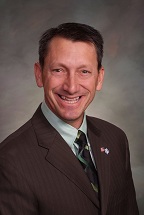State alternative fuel vehicles use alternative fuel less than a third of the time

By Arthur Kane | Watchdog.org
In the past 15 months, only a third — and often much less — of the fuel pumped into Colorado’s Compressed Natural Gas state vehicles was CNG, a database obtained by Watchdog.org shows.
At one point CNG use was less than 20 percent, but the state has substantially increased the use of CNG in the dual-fuel vehicles in the time period, setting a record in August of 34 percent, the data shows.
The CNG vehicles cost about $7,000 to $10,000 more than petroleum cars and trucks, but the program was sold as saving money, cutting greenhouse gases and creating a natural gas market for the state’s energy producers because the more expensive vehicles were going to run on the cheaper and cleaner CNG fuel.
State Sen. Greg Brophy, a Wray Republican who co-sponsored a 2009 bill requiring the state to buy alternative fuel vehicles where practical, said the Hickenlooper administration has botched a good idea.
IMPLEMENTATION CRITIC: State Sen. Greg Brophy, R-Wray, supports state purchases of CNG vehicles but thinks the state is doing it the wrong way.
“I believe this was more done to pat the backs of political patrons by our governor than to save the state money,” he said.
Watchdog.org’s initial stories in September uncovered memos that showed administration officials pushing the CNG vehicles on a reluctant Department of Natural Resources. DNR responded that the locations of many of their vehicles were too far from CNG pumps to make them useful and many of the trucks were not practical for their employees’ needs.
The state also is spending as much as $30 million in federal money to provide incentives for private businesses to buy CNG vehicles and open new CNG pumps despite one state-subsidized pump going out of business last year, records show.
Sabrina D’Agosta, spokeswoman for the Department of Personnel and Administration, said it will take time for state employees to increase CNG consumption, but officials believe the vehicles eventually will pay for themselves.
“The idea obviously, as with all new things, is we hope the use of CNG fuel increases over the lifetime of the vehicles,” she said. “While right now it’s under 30 percent, as more CNG fuel stations come online and more fleet managers move the vehicles where those fuel stations are located, consumption should go up. Our expectation was always that it would take a few years to see those results.”
The administration’s problem is that state law has specific requirements for when the fleet managers can purchase alternative fuel vehicles. A 2009 law only allows the purchase if the vehicle cost no more than 10 percent of a comparable petroleum car or truck, and the operating location has nearby fueling stations.
Last year, however, the Legislature modified the law to say the state can buy the vehicles if they are not 10 percent more costly over the life of the vehicles. The DPA staff say they have an analysis that shows even with 25 percent CNG fuel use those vehicles will be within that 10 percent cost difference.
“The DPA didn’t make a policy decision for state fleet to buy alternative fuel vehicles,” D’Agosta said. “To buy the vehicles was mandated to us by the Legislature. The governor is very supportive of CNG in general but it wasn’t a policy change.”
But state Sen. Kent Lambert, a Colorado Springs Republican who sits on the Joint Budget Committee, said the state may find it is in violation of the 10 percent provision — even the 2013 state law — when it goes to sell the vehicles in 10 years.
BUDGET MINDER – Sen. Kent Lambert said he will have state staff determine if the alternative fuel program is cost effective.
“They could be worthless if there are not enough places to fuel the vehicles,” he said. “Maybe the state should try to get the higher resale value now.”
In the past fiscal year, state vehicles used CNG about 25 percent of the time, and the rest of the time they vehicles were filled with more expensive gasoline, the database shows. However, August and September set records of CNG use with 34 and 32 percent, respectively, state databases show.
DNR, which has many far-flung outpost nowhere near CNG stations, has struggled with CNG vehicles, memos and the database shows. Only an average of 12 percent of the fuel going into DNR vehicles across the previous fiscal year was CNG. But in September, DNR nearly doubled that with 21 percent of the fuel used by their vehicles was CNG, the database shows.
D’Agosta said the data shows how fast the state is increasing CNG use.
“It is clear to this administration that CNG alternative fuel is better in a lot of ways,” she said. “If we can support that, it’s a good thing we’re doing.”
However, there are a substantial number of state vehicles used no CNG in the past two months, records show.
Lambert advocated removing the CNG vehicles from locations and departments that can’t find CNG stations nearby because it would save taxpayers more money.
“Maybe we have to make a change for DNR,” he said. “I can promise you that I’m going to have (the Joint Budget Committee) staff do an analysis of the issue.”







